The South Sinai region of Egypt is home to various birds, from small passerines to large raptors. Over 200 species of birds can be found in the area, making it an ideal destination for bird watchers.
Its beautiful landscapes and diverse habitats characterize the region, providing a suitable environment for various bird species.
From the coastal wetlands to the high mountains, South Sinai is an important area for migratory and resident birds.
24 Birds to Watch in South Sinai
South Sinai is a region of Egypt that is rich in natural beauty and biodiversity. It is home to many species of birds, some of which are endemic, rare or endangered. Here are 24 of the most amazing birds that you can see in South Sinai
1. Mallard
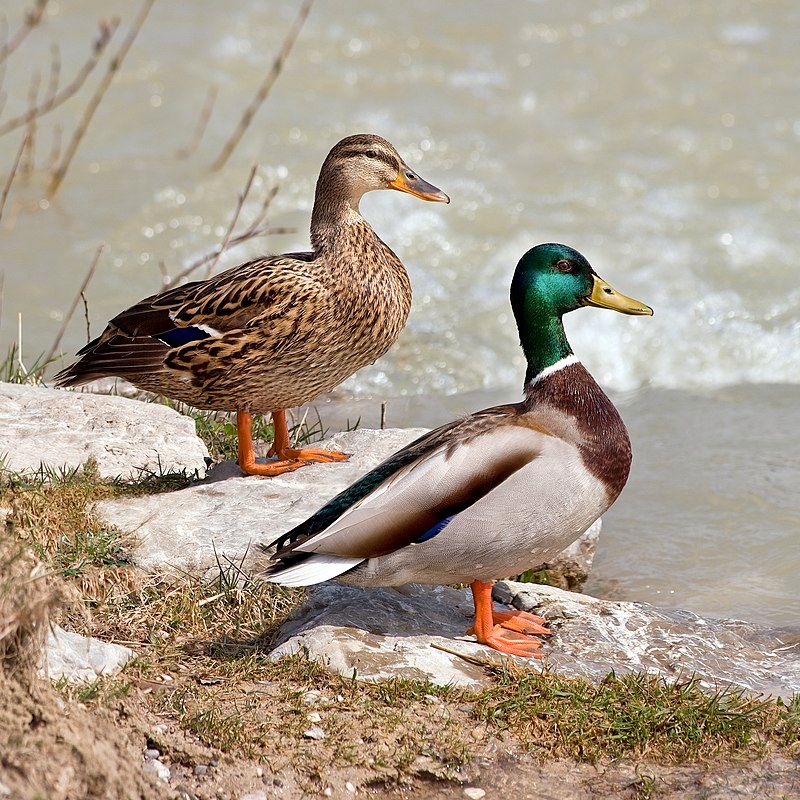
The mallard, or wild duck, is a prevalent bird species. It is a dabbling duck, which feeds by upending in shallow water and grazing on submerged aquatic vegetation.
It is found in many parts of the world that experience temperate and subtropical climates, such as the Americas, Eurasia, and North Africa. The mallard has also been introduced to many other places, mainly in the Southern Hemisphere.
This includes countries such as New Zealand, Australia, Peru, Brazil, Uruguay, Argentina, Chile, Colombia, the Falkland Islands, and South Africa.
These introductions were likely done to provide an additional food source for people living in these regions, as well as for recreational hunting. The mallard is an adaptable species, and as a result, it can thrive in various habitats.
This includes wetlands, rivers, streams, ponds, lakes, and even urban parks and gardens. It is a strong flier and can travel long distances between different bodies of water to feed and breed.
The mallard is one of the world’s most widespread duck species. Its wide range and adaptability make it an essential species in many different ecosystems, and its popularity as a hunting species makes it a valuable resource for many people.
| Kingdom | Animalia |
| Phylum | Chordata |
| Class | Aves |
| Order | Anseriformes |
| Family | Anatidae |
| Genus | Anas |
| Species | A. platyrhynchos |
2. Greater Flamingo
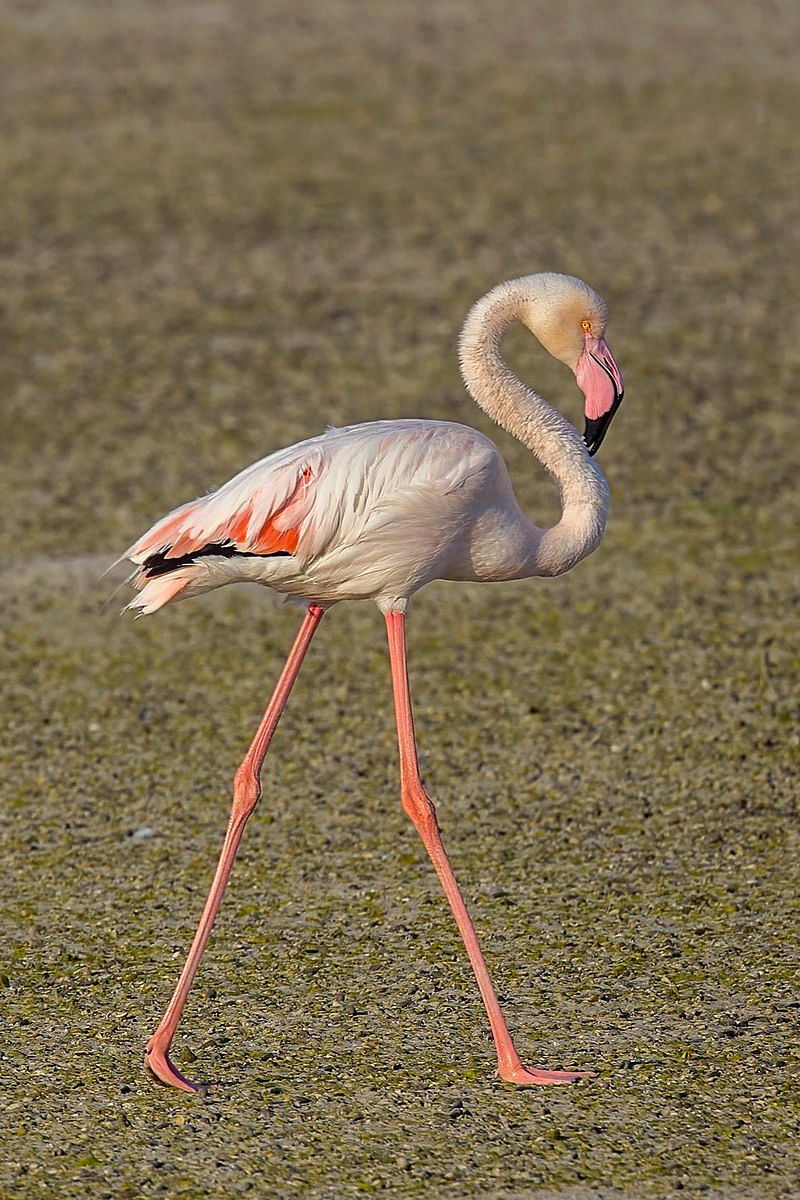
The greater flamingo is the most widely dispersed and tallest species of flamingo, found in many parts of the world.
It is native to the Old World, which includes Northern and Sub-Saharan Africa, the Indian Subcontinent, the Middle East, the Levant, the Persian Gulf, the Gulf of Aden, the Red Sea, and the Mediterranean region of Southern Europe.
This species of flamingo is known for its impressive size and vibrant pink feathers. The greater flamingo is a migratory bird that can travel long distances for food. It typically feeds on small aquatic creatures such as crustaceans, mollusks, and insects.
The bird also has an affinity for consuming algae and other aquatic plants. The greater flamingo is an essential species in its ecosystem, as it helps keep water clean and algae-free.
The presence of these birds also attracts other wildlife, such as other birds and mammals, to the area. The greater flamingo is an iconic species that is beloved by many. It is an integral part of many cultures and is featured in art, literature, and cuisine.
This species of flamingo is also an essential part of the global economy, as its feathers are used to make decorations, such as jewelry and clothing.
| Kingdom | Animalia |
| Phylum | Chordata |
| Class | Aves |
| Order | Phoenicopteriformes |
| Family | Phoenicopteridae |
| Genus | Phoenicopterus |
| Species | P. roseus |
3. Gadwall
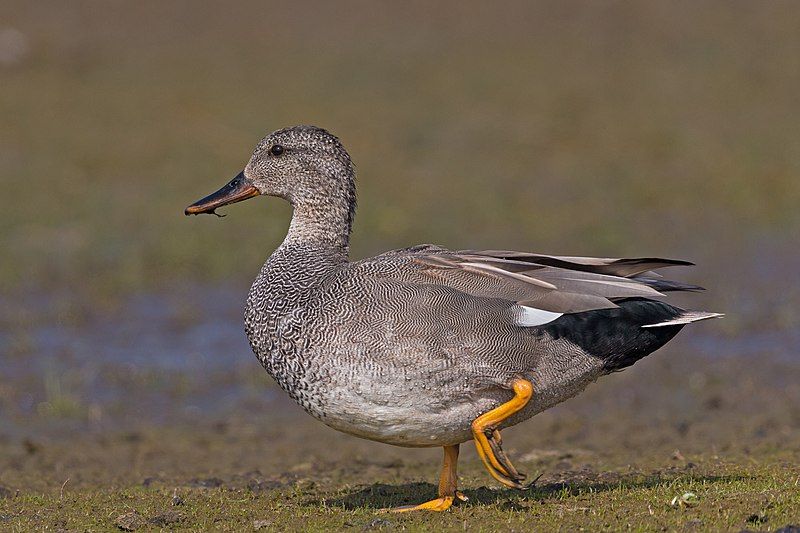
The gadwall is a species of duck that belongs to the family Anatidae. It is a dabbling duck, meaning it feeds mainly on the water’s surface rather than diving underwater like other ducks.
This species is found in many parts of the world, including Europe, Asia, and North America. It is considered to be one of the most widespread ducks in the family Anatidae. Gadwalls typically inhabit freshwater wetlands like lakes, ponds, and marshes.
They are a reasonably large duck species, with a length of up to 54 cm and a wingspan of up to 82 cm. Their plumage is grayish-brown primarily, with the males having a darker head, neck, and breast.
The beak is yellowish-green, and the legs and feet are olive-gray. Gadwalls feed mainly on aquatic plants, such as duckweed, aquatic grasses, and aquatic insect larvae. They also eat small fish, crustaceans, and mollusks.
These ducks form large flocks during the winter months and may migrate to more southern areas when the weather turns cold. They breed from April to May, and the female will lay up to 8 eggs in a nest near water.
The eggs will hatch after around 25 days, and the young will stay with the mother until they can fly. Overall, the gadwall is a widespread dabbling duck in Anatidae.
It is found in many parts of the world and is an essential species in the wetlands it inhabits.
| Kingdom | Animalia |
| Phylum | Chordata |
| Class | Aves |
| Order | Anseriformes |
| Family | Anatidae |
| Genus | Mareca |
| Species | M. strepera |
4. Black Stork
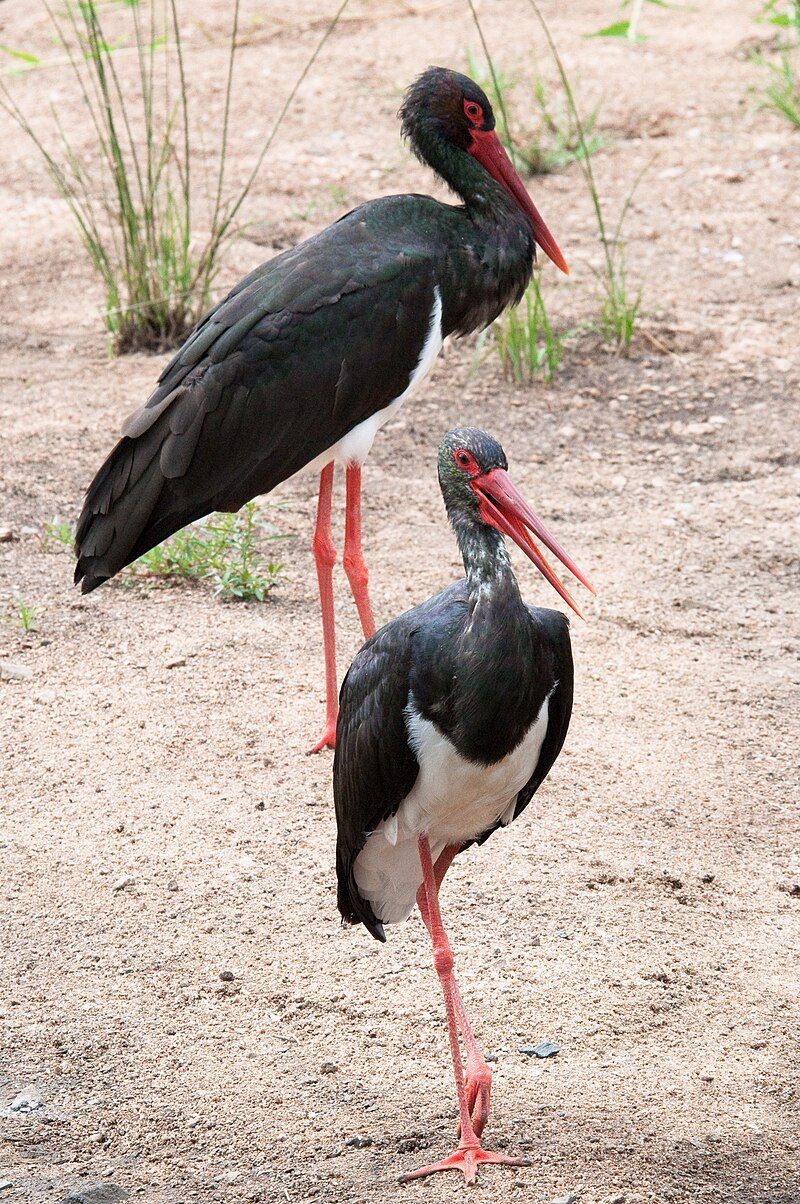
The black stork is a large bird belonging to the family Ciconiidae, a group of wading birds. Carl Linnaeus first described it in the 10th edition of his Systema Naturae, a landmark classification of plants and animals that he published in 1758.
The black stork is found in parts of Africa, Europe, and Asia and is known for its glossy black plumage and long red legs. It is a migratory species, spending the summer in the northern hemisphere and migrating to the southern hemisphere for the winter.
Black storks typically inhabit wetlands, streams, and rivers, feeding on fish, frogs, and small mammals. They build large nests in trees, usually near the water, and their young are cared for by both parents.
The black stork is an endangered species threatened by habitat loss and human disruption. Conservation efforts are being made to restore and protect the species and to increase its population numbers.
| Kingdom | Animalia |
| Phylum | Chordata |
| Class | Aves |
| Order | Ciconiiformes |
| Family | Ciconiidae |
| Genus | Ciconia |
| Species | C. nigra |
5. Garganey
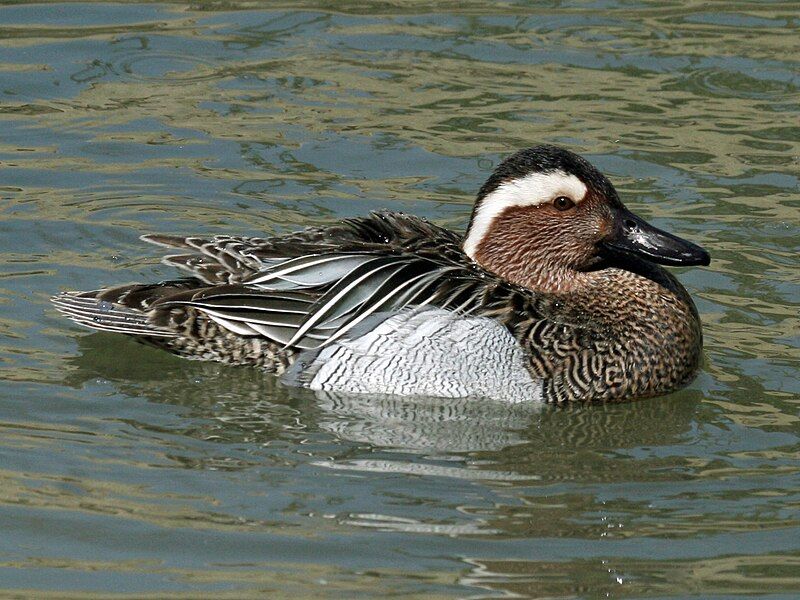
The garganey is a small dabbling duck breed throughout much of Europe and the Palearctic, spanning the northern parts of Africa, Europe, and Asia.
During the winter, the entire population of garganeys migrates to southern Africa, India, Bangladesh, and Australasia. When they reach these warmer climates, they often flock together in large numbers.
This type of migration is necessary to provide the ducks with the best chance of survival. As temperatures drop in the Northern Hemisphere, the ducks must find a place where there is an adequate food supply and a warmer climate.
By flying south for the winter, these ducks can take advantage of the resources in the warmer parts of the world.
| Kingdom | Animalia |
| Phylum | Chordata |
| Class | Aves |
| Order | Anseriformes |
| Family | Anatidae |
| Genus | Spatula |
| Species | S. querquedula |
6. Eurasian Wigeon
The Eurasian wigeon, also known as the European widgeon, is a duck species in the genus Mareca. It is a dabbling duck, meaning it feeds on the water’s surface or land rather than diving under the water.
It is found in the Palearctic, a biogeographic region encompassing the northern and central parts of the Old World, such as Europe, North Africa, and much of Asia.
The Eurasian wigeon is a widespread species in this region, and it can be found in various habitats, such as marshes, lakes, ponds, and estuaries.
It has a distinctive plumage with an overall grayish-brown head, light gray chest, white belly, and bright chestnut sides. The Eurasian wigeon is a vital game bird in many parts of the world and is also used as a food source in some places.
| Kingdom | Animalia |
| Phylum | Chordata |
| Class | Aves |
| Order | Anseriformes |
| Family | Anatidae |
| Genus | Mareca |
| Species | M. penelope |
7. Egyptian Goose
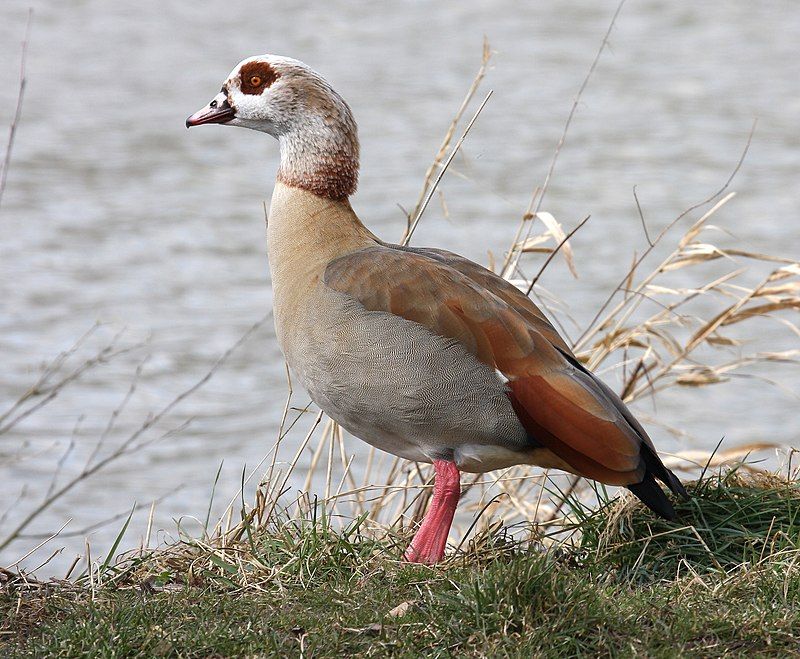
The Egyptian Goose is a species of duck native to Africa and is a member of the Anatidae family. It has become a much-loved ornamental bird, and as a result, it has been introduced to many other parts of the world.
This includes Europe, the United States, and other locations outside its natural range. The Egyptian Goose has become a popular pet, which is why it has been introduced to so many places. They are a striking duck species with a grey and brown feather pattern.
They have bright red bills and legs, which make them stand out in a flock of other ducks. They are also known for their playful and friendly nature, which makes them a delight to observe in the wild.
| Kingdom | Animalia |
| Phylum | Chordata |
| Class | Aves |
| Order | Anseriformes |
| Family | Anatidae |
| Genus | Alopochen |
| Species | A. aegyptiaca |
8. Common Redshank
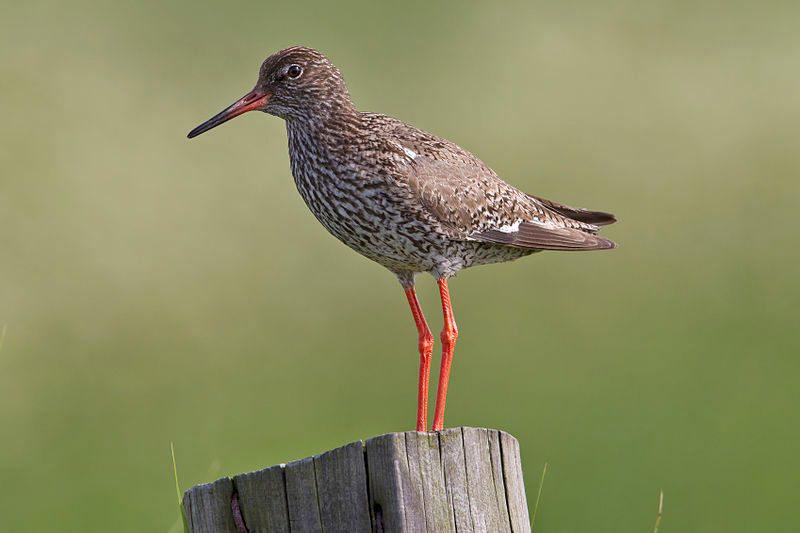
The common redshank is a type of wading bird found in Eurasia. It belongs to the Scolopacidae family, one of the world’s most prominent bird families. The common redshank is characterized by its distinctive red legs and long, slender beaks.
It has a grey-brown back, wings, white underparts, and a black eye stripe. It typically inhabits coastal areas, marshes, and other wetland habitats. The redshank is expected in the UK and Europe, where it can be seen foraging in shallow waters.
Its diet consists of crustaceans, insects, and worms, which it finds in muddy areas. The redshank is also a migratory species found in Africa and Asia during the winter. It returns to its breeding grounds in Europe and Asia during the summer months.
The redshank is an essential species in wetlands, as it helps to regulate insect populations. It is also an important indicator species of wetland health, and its presence is used to help monitor the health of wetland habitats.
| Kingdom | Animalia |
| Phylum | Chordata |
| Class | Aves |
| Order | Charadriiformes |
| Family | Scolopacidae |
| Genus | Tringa |
| Species | T. totanus |
9. Eurasian Teal
The Eurasian Teal is a type of duck found in many parts of Europe and Siberia. It is also known as the Common Teal or the Eurasian Green-winged Teal. This species of duck is prevalent and breeds during the temperate months in Eurosiberia.
During the winter months, the Eurasian Teal migrates south to warmer climates. It is often called the Teal because it is the only type of small dabbling duck in much of its range.
The Eurasian Teal is a reasonably small duck, reaching an average length of about 15 inches. It is easily identifiable by its green wings and its greyish-brown body.
The Eurasian Teal is a very adaptable duck species and can often be found in various habitats ranging from wetlands to open fields. It is an essential species for recreational and commercial hunters, as its meat is considered a delicacy.
| Kingdom | Animalia |
| Phylum | Chordata |
| Class | Aves |
| Order | Anseriformes |
| Family | Anatidae |
| Genus | Anas |
| Species | A. crecca |
10. Sooty Gull
The sooty gull is a medium-sized gull species found in the family Laridae. It is also commonly called the Aden gull or Hemprich’s gull.
This gull species is found in tropical and subtropical regions of the world, including the coasts of the Indian Ocean, the Red Sea, and the east coast of Africa. It has a distinctive plumage: a black head and neck, gray back, and white chest.
The wings are black with white tips, and the tail is white with black corners. Its diet consists of fish, crabs, insects, and other invertebrates. The sooty gull is an opportunistic feeder, often in large flocks along the shoreline.
It is also known to scavenge, stealing food from other birds. The sooty gull is considered a fairly common species, though its population is decreasing due to habitat loss and overfishing.
| Kingdom | Animalia |
| Phylum | Chordata |
| Class | Aves |
| Order | Charadriiformes |
| Family | Laridae |
| Genus | Ichthyaetus |
| Species | I. hemprichii |
11. Sand Partridge
The sand partridge is a gamebird that belongs to the pheasant family, Phasianidae. This family is part of the order Galliformes, which includes gallinaceous birds such as chickens, turkeys, quail, and grouse.
The sand partridge is native to the region stretching from Egypt and Israel to South Arabia. It is a common bird of the Middle East, inhabiting various habitats such as deserts, grasslands, and dry shrublands.
The sand partridge is a small, stocky gamebird with a mottled brown and white plumage. This species is generally shy and prefers to avoid human settlements. Males and females look similar, although males tend to be larger than females.
The sand partridge is an omnivorous species, feeding mainly on plants, insects, and small invertebrates. It can often be seen in pairs or small groups, foraging on the ground for food.
| Kingdom | Animalia |
| Phylum | Chordata |
| Class | Aves |
| Order | Galliformes |
| Family | Phasianidae |
| Genus | Ammoperdix |
| Species | A. heyi |
12. Common Shelduck
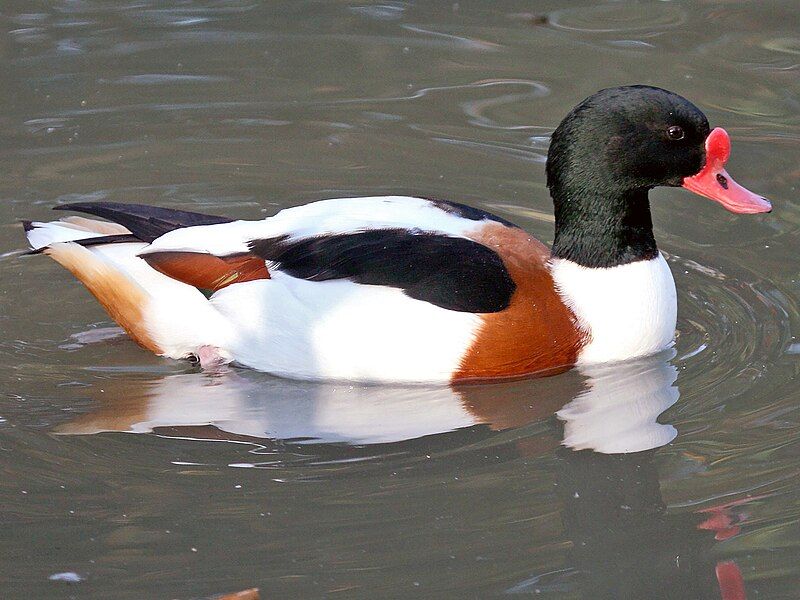
The common shelduck is a species of waterfowl from the genus Tadorna. It is widely distributed in the Euro-Siberian region of the Palearctic, where it breeds in temperate climates and winters in subtropical areas.
It can also be found in the Maghreb region during the winter. This species of shelduck is relatively common in its range, making it a regular sight in many of the areas it inhabits.
The common shelduck is an attractive species, with its striking black and white plumage and bright orange bill and feet. It feeds mainly on aquatic plants, mollusks, and small aquatic insects and can often be seen in large flocks on coastal mudflats or inland wetlands.
This species of shelduck is quite friendly and is often observed interacting with other waterfowl species. They may also be seen in mixed flocks with waders, such as curlews and godwits.
The common shelduck is an important species in the Euro-Siberian region, and its conservation is essential to the health of the region’s wetlands.
| Kingdom | Animalia |
| Phylum | Chordata |
| Class | Aves |
| Order | Anseriformes |
| Family | Anatidae |
| Genus | Tadorna |
| Species | T. tadorna |
13. Northern Pintail
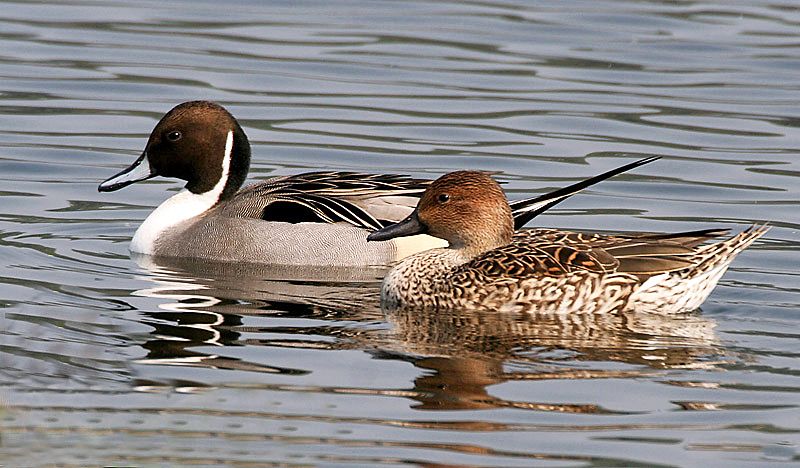
The pintail, or northern pintail, is a duck species found worldwide. It breeds in northern Europe, the Palearctic region, and North America. During the cold winter, the pintail migrates south, often reaching as far south as the equator.
This broad geographic range makes the pintail a very adaptable species, allowing it to thrive in various habitats. The pintail is an omnivore whose diet comprises multiple plants and animals.
Its long neck and bill help it forage for food in shallow and deep waters. In addition to its wide geographic range, the pintail is also known for its elegant appearance.
Its long, pointed tail feathers and brownish-gray coloration give the bird a graceful look in flight. The male pintail is larger than the female, with a more prominent white-tipped tail.
The pintail is essential to many ecosystems, and its broad geographic range helps ensure its survival.
| Kingdom | Animalia |
| Phylum | Chordata |
| Class | Aves |
| Order | Anseriformes |
| Family | Anatidae |
| Genus | Anas |
| Species | A. acuta |
14. Tufted Duck
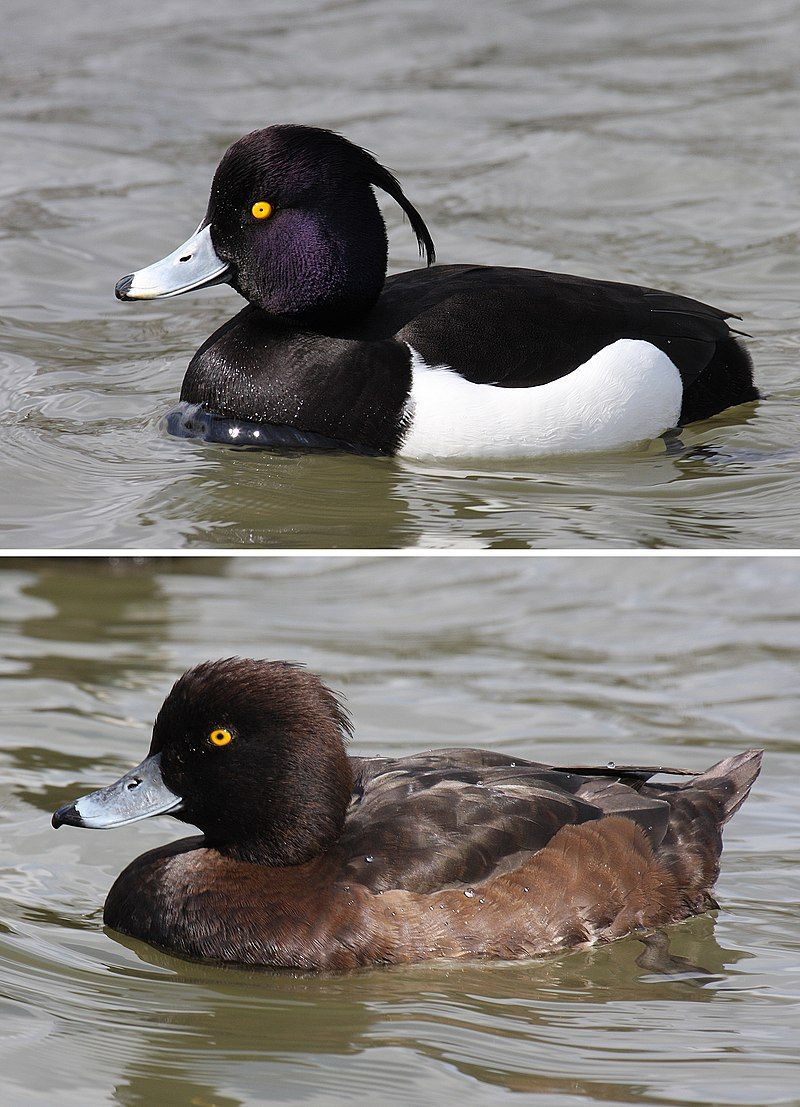
The Tufted Duck, also known as a Tufted Pochard, is a small species of diving duck found in northern Eurasia. It is estimated that the population of Tufted Ducks is close to one million birds.
The scientific name of Tufted Ducks, Aythya Fuligula, is derived from Ancient Greek and Latin.
The root of the name, Aythya, comes from the Ancient Greek word ‘Lithuania,’ which describes an unidentified seabird that authors like Hesychius and Aristotle mentioned.
The second part of the name, ‘Fuligula,’ is derived from the Latin word ‘logo,’ which means ‘soot,’ and ‘gula,’ which means ‘throat.’ This part of the name likely refers to the dark coloration of the Tufted Duck’s throat.
| Kingdom | Animalia |
| Phylum | Chordata |
| Class | Aves |
| Order | Anseriformes |
| Family | Anatidae |
| Genus | Aythya |
| Species | A. fuligula |
15. Black-Headed Gull
The black-headed gull is a species of small gull found in regions spanning much of the Palearctic, ranging from Europe to coastal eastern Canada.
Most black-headed gull populations are migratory birds, meaning they fly south to warmer climates during winter. However, some birds of this species remain in western Europe’s mildest areas year-round.
This gull species is a well-known bird and can often be seen eating small fish, crustaceans, and insects from the shoreline or searching for food in fields and meadows. The black-headed gull is easily recognizable by its black head, white body, and grey wings.
It is a beautiful bird often admired by bird watchers and nature enthusiasts.
| Kingdom | Animalia |
| Phylum | Chordata |
| Class | Aves |
| Order | Charadriiformes |
| Family | Laridae |
| Genus | Chroicocephalus |
| Species | C. ridibundus |
16. Pallas’s Gull
Pallas’s gull, also known as the great black-headed gull, is a large species of bird found in various parts of the world. It is traditionally classified in the genus Larus, a seagull genus.
The species’ scientific name comes from Ancient Greek, with the first part, Ichthyaetus, coming from ichthus, meaning “fish,” and the second part, autos, meaning “eagle.”
This reflects the aquatic lifestyle of the gull as well as its predatory nature. The Pallas’s gull is a large species, with adults having a wingspan of up to 1.4m.
They are easily identifiable by their black heads, which contrast with their white bodies, and their yellow-green legs and feet, which are usually visible.
They are mainly found near coastal areas, feeding on fish, crustaceans, and other marine life. The Pallas’s gull is classified as a vulnerable species due to its declining population.
This is caused by various factors, including human activities such as overfishing, water pollution, and the destruction of their habitats. There is also increasing competition for resources from other species of birds, such as the herring gull.
Conservation efforts are underway to protect the species and to ensure its long-term survival.
| Kingdom | Animalia |
| Phylum | Chordata |
| Class | Aves |
| Order | Charadriiformes |
| Family | Laridae |
| Genus | Ichthyaetus |
| Species | I. ichthyaetus |
17. White-Eyed Gull
The white-eyed gull is a small gull species only found in the Red Sea. Its closest relative is the sooty gull. The International Union for Conservation of Nature (IUCN) classifies the species as least Concerned, which means that it is not threatened with extinction.
Human activities and oil pollution are the main threats to the white-eyed gull. Gulls are typically classified in the genus Larus, and the white-eyed gull is no exception. It is a part of this genus, a large group of seabirds.
These birds are found in coastal areas worldwide and are known for their scavenging habits. They are also very resilient, so the white-eyed gull is still called Least Concern.
The white-eyed gull is a species worth protecting, as it is an integral part of the Red Sea’s natural biodiversity. Its traditional place in the genus Larus is a testament to its evolutionary success and ability to adapt and survive in a changing environment.
Hopefully, with continued conservation efforts, the white-eyed gull can avoid the threat of extinction and continue to thrive in the Red Sea for many years.
| Kingdom | Animalia |
| Phylum | Chordata |
| Class | Aves |
| Order | Charadriiformes |
| Family | Laridae |
| Genus | Ichthyaetus |
| Species | I. leucophthalmus |
18. Little Gull
The little gull is a species of gull that is found in northern Europe and across the Palearctic. It is a small gull and has earned its scientific name, Hydrocoloeus minutus, from its size and habitat.
The genus ‘Hydrocoloeus’ comes from the Ancient Greek words ‘hydro’ and ‘colors,’ meaning ‘water’ and a sort of web-footed bird,’ respectively. The species name ‘minutes’ is Latin for ‘small.’
This reflects the small size of the little gull, one of the smallest gull species. The little gull is an adaptable species usually found near waterways, lakes, and coasts.
It is an omnivorous species, feeding on insects, small fish, and other invertebrates.
| Kingdom | Animalia |
| Phylum | Chordata |
| Class | Aves |
| Order | Charadriiformes |
| Family | Laridae |
| Genus | Hydrocoloeus |
| Species | H. minutus |
19. Laughing Dove
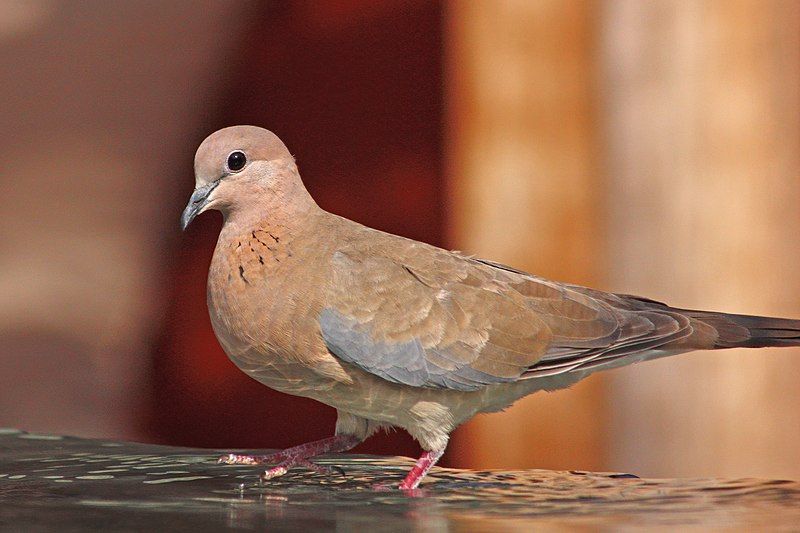
The Laughing Dove is a small species of pigeon found in various habitats across Africa, the Middle East, South Asia, and Western Australia.
This species is a resident breeder, meaning it chooses to live in a particular area year-round rather than migrating to a different region for breeding. In Western Australia, the Laughing Dove has become established in the wild after being released from Perth Zoo in 1898.
This release allowed the species to establish several populations in the area, allowing it to thrive and spread. The Laughing Dove is a common sight in many parts of the region, and its presence is a testament to the success of this release.
It is a resilient and adaptable species, establishing itself in the wild after being released from captivity.
| Kingdom | Animalia |
| Phylum | Chordata |
| Class | Aves |
| Order | Columbiformes |
| Family | Columbidae |
| Genus | Spilopelia |
| Species | S. senegalensis |
20. Namaqua Dove
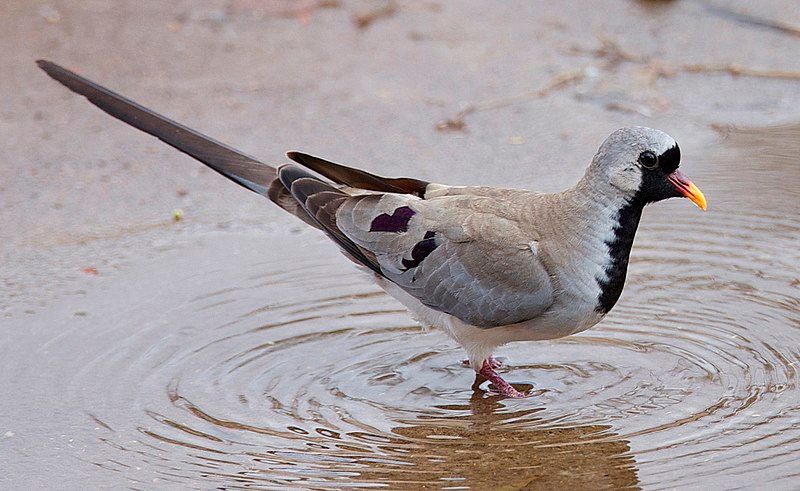
The Namaqua dove is a small pigeon species found in many parts of the world. It is the only species in the genus Oena, a group of related birds. The Namaqua dove is most commonly found in Sub-Saharan Africa but can also be found in Arabia and Madagascar.
It is a small bird with grayish-brown plumage, white barring on its wings, and a white patch on its neck. It is a strong flier and can fly up to great heights. Its diet consists mainly of seeds, berries, and insects.
It is a social species and often lives in pairs or small groups. The Namaqua dove is also an essential species in the ecosystems it inhabits, acting as a pollinator and seed disperser. Its population is stable, and it is not considered to be threatened.
| Kingdom | Animalia |
| Phylum | Chordata |
| Class | Aves |
| Order | Columbiformes |
| Family | Columbidae |
| Genus | Oena |
| Species | O. capensis |
21. Red-Billed Tropicbird
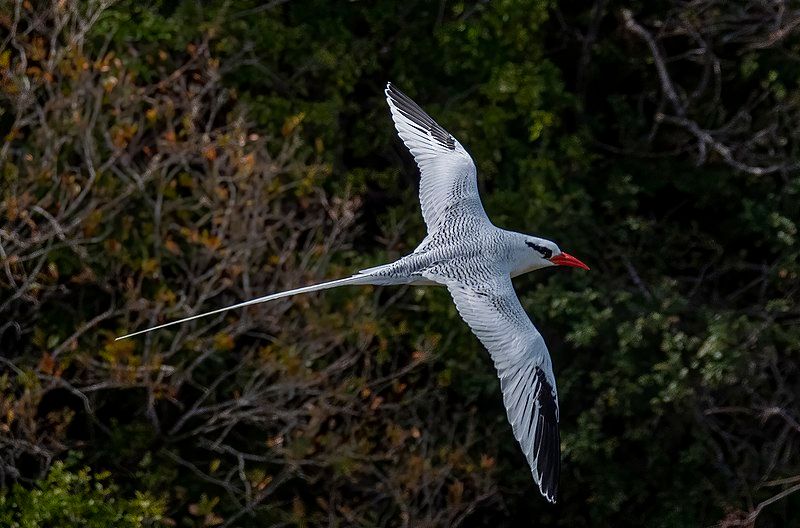
The red-billed tropicbird is a seabird species found in tropical oceans. It is one of three closely related species of tropicbirds. The red-billed tropicbird has a distinctive appearance, primarily white feathers and black markings on its wings and back.
It has a black mask on its face, and its bill is a bright red, giving it its common name. Overall, the red-billed tropicbird has an elegant and eye-catching look.
The red-billed tropicbird is an active flier who flies for food. It has a unique flight form known as “healing,” which can rapidly shift its body angle to make quick turns.
This helps the red-billed tropicbird to maneuver in search of its prey quickly. It mainly feeds on fish, squid, and other marine creatures. The red-billed tropicbird is a pretty common species and can be found in tropical oceans worldwide.
It usually nests on cliffs or trees in colonies, and the birds can often be spotted flying around these areas. The red-billed tropicbird is an essential species in the marine environment, and its presence indicates a healthy marine ecosystem.
| Kingdom | Animalia |
| Phylum | Chordata |
| Class | Aves |
| Order | Phaethontiformes |
| Family | Phaethontidae |
| Genus | Phaethon |
| Species | P. aethereus |
22. Mediterranean Gull
The Mediterranean gull is a small gull whose scientific name is derived from Ancient Greek. Ichthyaetus has two elements: ichthus, which means “fish,” and autos, which means “eagle.”
The specific melanocephalus comprises two parts: melas, which means “black,” and -cephalous, which means “-headed.” Together, these two terms form the scientific name of the Mediterranean gull, indicating that it is a black-headed gull species.
This gull species is typically found in coastal areas around the Mediterranean Sea and is a common sight for beachgoers and other visitors to the region.
| Kingdom | Animalia |
| Phylum | Chordata |
| Class | Aves |
| Order | Charadriiformes |
| Family | Laridae |
| Genus | Ichthyaetus |
| Species | I. melanocephalus |
23. Slender-Billed Gull
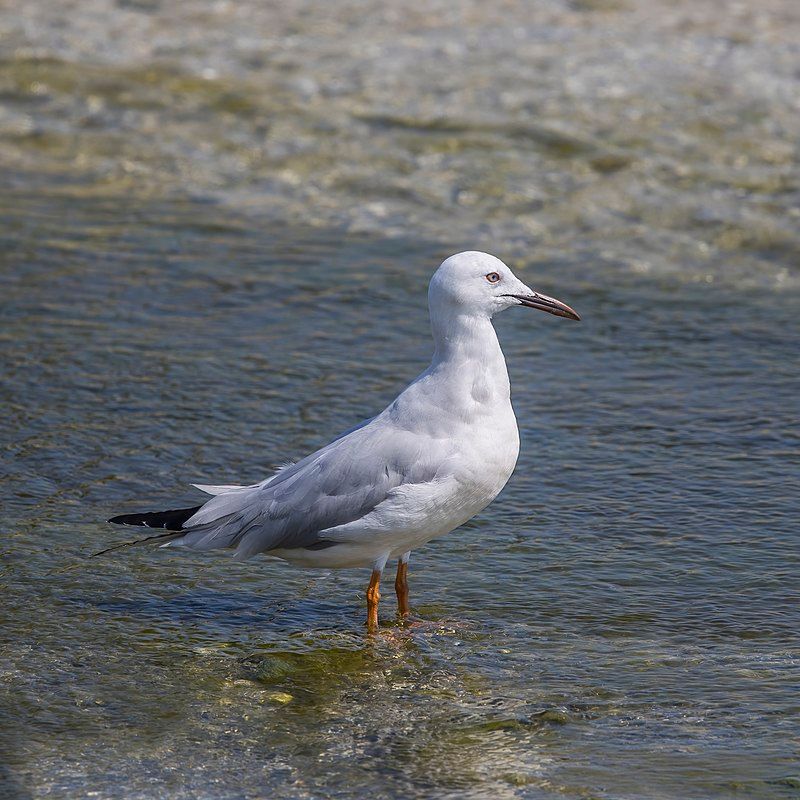
The slender-billed gull is an average-sized bird of the gull family that is found breeding in some areas around the Mediterranean Sea and the north of the western Indian Ocean.
This bird can be found on islands and coastal lagoons and generally migrates in the winter months, traveling further south to North Africa and India.
This gull is not very widely distributed, as it is only found in a few areas, and is considered a vulnerable species due to its limited range. It is an omnivore, eating both plant-based and animal-based foods.
It eats fish, crustaceans, insects, and even carrion. The slender-billed gull is also known to scavenge food from other birds and humans. This species is a rather social bird, often seen in flocks and forming nesting colonies.
It is an essential species for its role in helping to preserve specific fragile coastal ecosystems.
| Kingdom | Animalia |
| Phylum | Chordata |
| Class | Aves |
| Order | Charadriiformes |
| Family | Laridae |
| Genus | Chroicocephalus |
| Species | C. genei |
24. White-Headed Duck
The white-headed duck is a small species that measures around 45 cm in length. The males have a distinct look, with a white head, black crown, blue bill, and reddish-grey plumage. Females are slightly duller in color, with a dark bill.
During the breeding season, they inhabit lakes with open water and plenty of vegetation at the edges. This vegetation provides the ducks a safe place to nest and feed on aquatic insects.
The white-headed duck is a shy species and prefers to keep a distance from humans, so it is essential to be respectful and not disturb them while they are breeding.
| Kingdom | Animalia |
| Phylum | Chordata |
| Class | Aves |
| Order | Anseriformes |
| Family | Anatidae |
| Genus | Oxyura |
| Species | O. leucocephala |
Conclusion
South Sinai has a diverse population of birds, with many species endemic to the region. Its unique habitats and ecosystems provide an ideal home for various birds, from raptors to songbirds.
The region’s bird population is an integral part of the overall biodiversity of South Sinai and is an essential indicator of the health of the environment. Protecting and conserving these birds and their habitats for future generations is critical.